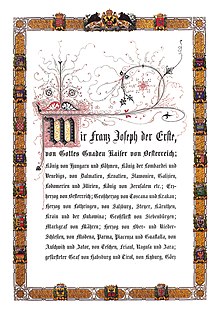February patent
In Austrian historiography, the February patent is the constitution of the Austrian monarchy (according to the emperor in his patent), i. H. of the Austrian Empire , from 1861 . It was issued on February 26, 1861 and on February 28 in the RGBl. released. In the appendix, the state regulations of the non-Hungarian crown lands valid until 1918 were announced ; for the Hungarian countries, reference was made to the October 1860 diploma . The enactment of these fundamental legal rules fell during the period of neo-absolutism and was therefore the sole decision of Emperor Franz Joseph I.
The February patent and the development up to the December constitution of 1867
The centralized February constitution was drawn up by the Minister of State Anton von Schmerling and put into effect on February 26, 1861 by the February patent, d. H. Issued by Emperor Franz Joseph for the entire monarchy. It largely replaced the federal October diploma of 1860.
At that time there was disagreement among the leading layers of the monarchy as to whether the state as a whole should become a centrally controlled power or essentially a federation of largely independent crown lands . Magyar politicians consistently advocated a role for the Kingdom of Hungary as independent as possible - which they should finally achieve with the compromise of 1867 . The imperial ministers, on the other hand, made increasing efforts to strengthen the central power of the monarchy.
In the February constitution, legislation was divided between the emperor and the two houses of the imperial council . The House of Representatives of the Reichsrat was to be formed by representatives sent by the state parliaments. However, this regulation was rejected by Hungary and partly by Galicia as being too centralistic. The Hungarian politicians boycotted them wherever possible.
Without having become fully effective, the Basic Law on Imperial Representation announced in the February patent was suspended by the Kaiser on September 20, 1865 with the unofficially so-called suspension patent, i.e. H. temporarily overridden. The emperor justified this in his manifesto on the same day: A large part of the empire, as warm and patriotic as the hearts beat there, persistently kept away from the common legislative activity. But he could not negotiate with Hungary about rules that were also legally binding in other parts of the empire; therefore the suspension of the rules on the Imperial Council is necessary in all parts of the monarchy.
The constitutional form of government came about two years later, after the settlement with Hungary: The December constitution of 1867 was based on the February patent for the non-Hungarian (" cisleithan ") countries of the Habsburg monarchy. (Hungary was now only linked to these countries by a real union, domestically a separate state.) Legislative periods and sessions of the Reichsrat were numbered from 1861 to the end of the Austrian monarchy in 1918. Until 1873, the members of the Reichsrats were still to be elected and sent annually by the state parliaments of the crown lands.
The original of the February patent
The original of the February patent was long lost. It was probably stolen before the Vienna Palace of Justice fire in 1927. A private individual found the document in an antiquarian bookshop, bought it and, as reported on March 31, 2014, gave it to the State Archives .
See also
Web links
- The constitutional document, unofficially called February Patent , RGBl. No. 20/1861 , in the then Austrian law gazette ; Website of the Austrian National Library
- The full text of the February patent
- Entry on February patent in the Austria Forum (in the AEIOU Austria Lexicon )
Individual evidence
- ↑ RGBl. No. 20/1861 p. 69 ff.
- ↑ RGBl. No. 89/1865 p. 303
- ↑ RGBl. No. 88/1865 p. 301
- ↑ Original of the “February patent” from 1861 secured. derStandard.at , March 31, 2014, accessed on March 31, 2014 .
